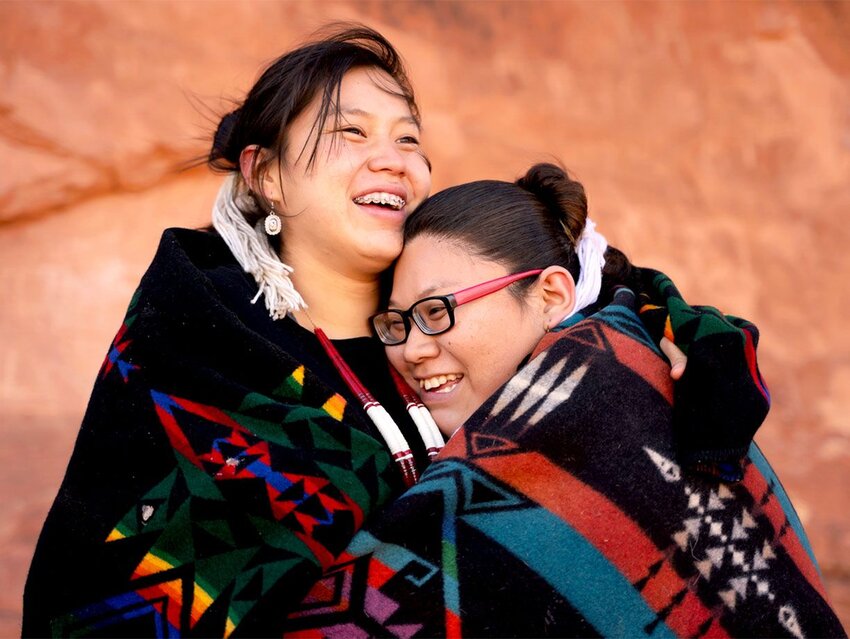There were once at least 300 Indigenous languages with 1.5 million speakers in pre-Columbian North America, but a third of these languages are now extinct. Most Indigenous languages that are spoken now are known by only a few thousand (or even a few dozen) people. Today, just a handful of Indigenous languages in North America have more than 10,000 speakers. Let’s take a look at six of these languages still spoken in the U.S.
Navajo
Primary location: Arizona and New Mexico
Approximate speakers: 169,471
The Navajo are one of the most populous Native American peoples in the United States. Their language has been resolutely preserved: Out of over 300,000 Navajo in the U.S., more than half speak the language, making it the most widely spoken Indigenous language in the United States.
Yup’ik
Primary location: Alaska
Approximate speakers: 18,950
Central Alaskan Yup'ik is the largest dialect of the Yup’ik languages, with around 15,000 speakers. The tribes that speak this dialect live on the western coast of Alaska near the Norton Sound and Bristol Bay. Other Yup’ik dialects in the region account for the remaining speakers.
Dakota
Primary location: North and South Dakota, Nebraska, Minnesota, and Montana
Approximate speakers: 18,616
The Dakota language belongs to the Mississippi Valley Siouan language branch. Its two main dialects are Eastern and Western Dakota. The Dakota people are comprised of four main groups: the Isanti (or eastern Dakota), the Yanktonai and Yankton (both in current South Dakota), and the Teton (also known as Lakota).
Apache
Primary location: Arizona, New Mexico, and Texas
Approximate speakers: 13,063
Apache is still spoken in the American Southwest and can be further broken down into two dialects, Western and Eastern Apache. However, speakers of each language are not necessarily fluent in the other. This is equivalent to the relationship between Romance languages such as French and Italian — they are similar, but speakers are not automatically fluent in both.
Keres
Primary location: Northern New Mexico
Approximate speakers: 12,945
The Keres are a group of Pueblo people who live in tribes along the Rio Grande and its tributaries, mainly in northern New Mexico. They are the only known people who still speak dialects of the Keres language, which has no known relationships to any other Native languages.
Cherokee
Primary location: Oklahoma
Approximate speakers: 11,610
The Cherokee people once inhabited much of the American South, including Virginia, West Virginia, North Carolina, South Carolina, Georgia, Alabama, Kentucky, and Tennessee. After being pushed westward, the modern Cherokee population ended up mainly in Oklahoma. Today, only a small percentage of people still speak Cherokee, but in the early 19th century, the Cherokee language became the first Native American language to develop a writing system.
7 Native American Words Adopted Into English
These modern words originated in Indigenous languages from all over North America. Although many of these dialects are not widely spoken today, they have left a lasting mark on the English language.
Caucus
“Caucus” is a political buzzword that describes a meeting among members of the same party to decide on candidates or policy. It was likely derived from a Virginia dialect of Algonquian, from the word caucauasu, meaning “counselor, elder, or adviser.”
Pecan
A perfect ingredient for a pie, the pecan was named pakani (which simply meant “nut”) by the Illinois tribe. Other tribes had similar names for “nut,” including the Cree pakan (“hard-shelled nut”), the Ojibwa bagaan, and the Abenaki pagann.
Michigan
More than half of U.S. state names were derived from Native American words and phrases. One example is the Midwestern state of Michigan, whose name came from the Ojibwa word meshi-gami, descriptively meaning “big lake.”
Caribou
A caribou is a large reindeer found in North America. When Europeans arrived on the continent, they often used Native American words to describe the new animals they encountered, and “caribou” is a prime example of this. This word came from Algonquian, specifically the Micmac tribe, from the word kaleboo. This name also meant “pawer” or “scratcher” in Algonquian, relating to how caribou feed by kicking snow aside to reach grass and moss.
Saguaro
The saguaro is a symbol of the American Southwest — it is the namesake of Saguaro National Park in Tucson, Arizona. But the word “saguaro” first appeared in the Ópata language, spoken by tribes in the desert region of southeastern Arizona and throughout the Mexican state of Sonora.
Raccoon
Most people have come across a scavenging raccoon in their garbage, just as the Native Americans must have centuries ago. The Powhatans named them arahkun, from the term arahkunem, meaning “he scratches with the hands.”
Moose
We can only imagine what European settlers thought when they first encountered one of the largest land mammals in North America. The word “moose” was derived from an Algonquin language, either the Narragansett moos or the Abenaki moz, both likely related to the term moosu, meaning “he strips off,” in reference to the animal’s behavior of stripping bark off trees in search of food during the winter.
Featured image credit: THEPALMER/ iStock

